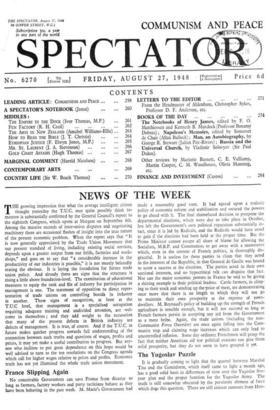The Yugoslav Puzzle
It is gradually coming to light that the quarrel between Marshal Tito and the Cominform, which itself came to light a month ago, has a good solid basis in differences of view over the Yugoslav five- year plan and the proper function for the Yugoslav Army. The truth is still somewhat obscured by the persistent element of farce which dogs this question. There are still sinister rumours from Hun- gary of hideous sacrilege such as the hanging of large portraits of Tito side by side with very small portraits of Marx and Engels. In Trieste there has been some awkwardness over the fact that the most vociferous supporters of the Cominform are Italians, while the most loyal Slav supporters of Tito are a small governing minority. But in Belgrade, indirectly and often inadvertently, the facts come out that the officers who are daily escaping into Rumania and Hungary were ready to fall in with the Russian policy of making the Yugoslav Army a specialist subsidiary of the Red Army, while Tito himself favours the view that his army should be a balanced and independent unit. Russian dissatisfaction with the inadequate measures for the liquidation of independent peasant holdings and the more-than- adequate measures for Yugoslav industrial development grows plainer. This quarrel has a real basis. But it is still impossible to forecast how it will end. The purge of the army and other public services of over-zealous Cominform elements goes on at the risk that it will weaken the Yugoslav State beyond endurance. There has been a Yugoslav protest against the hostile Rumanian attitude. Marshal Tito is lying low. But before long he must speak, the Uncertainties of the five-year plan must be resolved, and the future orders for the army must be revealed. And before long it must also be shown whether Yugoslavia can stand on its feet economically without Russian aid and, if so, how.



































